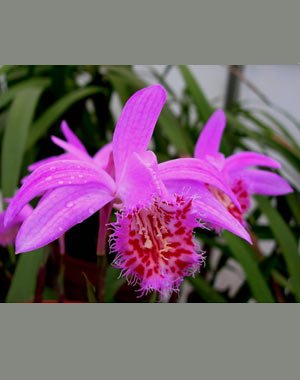Pleione (pronounced plye-OH-nee) is a genus endemic to the foothills of the Himalayas spreading eastwards across China to Taiwan. They are deciduous perennials which are usually spring-flowering and most of which are easy to grow, making them an ideal beginner’s orchid. Some species are ground growing (terrestrial) while others prefer living on moss-laden tree branches (epiphytic).
The beautiful flowers last for about three weeks and are sometimes fragrant. Species and hybrids come in a variety of flower colours including reds, purples, pinks, yellows, peaches, creams and whites. The flower lips, which are often “hairy”, are usually intricately spotted red or yellow.
Ideally they should have a growing mix of fine bark and perlite with a good quantity of moss if available.
Did you know…
The orchid genus Pleione was named after the a sea nymph who married the god Atlas according to Greek mythology.
Temperature
Cool. Night temperatures of between 10° and 12°C with a daytime rise of about 10°C.
Light
Moderate.
Pleione Growing Cycle
Spring (March – May)
- In early March place the dormant pseudobulbs in pots on the soil surface but do not bury them and do not water the compost.
- Position on a sunny windowsill indoors in a cool unheated room and again do not water. If placed in a warm room at the start of the season, the new leaves may develop prematurely and the emerging flower bulbs will die off.
- As the days get brighter the flower buds will emerge slowly from the leafless, rootless bulb.
- Only begin to water sparingly around the newly emergent roots when they are about 1cm in length, this is usually shortly after flowering has finished.
- Never soak the pot compost until the roots are strong and well established. Most Pleiones are killed by over-watering in the early spring.
Summer (May – October)
- After flowering, a single green leaf develops from the base of the flower stem.
- The roots will then become more vigorous and from then on watering should be regular about once a week, allowing the compost to almost dry out on each occasion.
- Feed periodically with a standard houseplant fertiliser. The pots can be positioned outdoors after the last frost until the autumn (they can also be grown in an unheated green house).
- The leaf will continue to grow until September after which time the new bulb will begin to swell and last year’s old bulb will be seen to die off.
- Each bulb should have produced at least two shoots that will swell to become the next years bulbs. Therefore each year your Pleione collection should be doubling in number.
Autumn (October – November)
- In late summer when the leaf tips begin to yellow, reduce watering.
- When the leaves turn completely yellow, watering should be stopped.
- Once the leaves have died off, lift the bulbs out of their pots and trim off all the roots and detach and discard the shrivelled previous season’s bulb. Be careful not to damage the “eye” at the base of bulb which is where next year’s growth will begin. If you break it off the bulb will not re-grow.
- Place the individual bulbs on a sheet of paper in a warm room for about two days to dry-off.
- Then store the dormant bulbs boxed in a cool dark place indoors until the following February. Some growers even store their bulbs in a fridge!
- Do not expose to frost or damp during the dormancy. The bulbs of the species Pleione praecox are an exception in that they should be kept above 10°C during the winter rest. It will start to produce new roots and even leaves in January but restrain from watering until the roots are at least 2cm in length. This species is also unusual in that it is autumn flowering.

